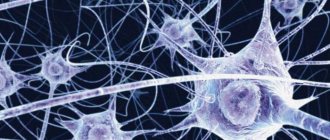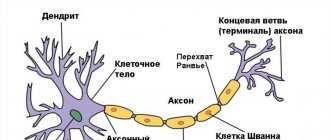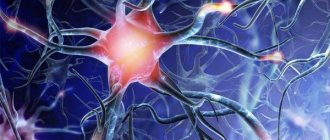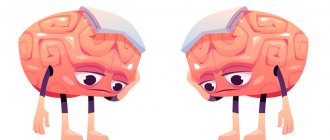About a year and a half ago, I posted a series of video lectures on Habr with my vision of how the brain works and what are the possible ways to create artificial intelligence. Since then, significant progress has been made. Some things were better understood, some things were modeled on a computer. What’s nice is that there are like-minded people actively participating in the project.
In this series of articles we plan to talk about the concept of intelligence that we are currently working on and demonstrate some solutions that are fundamentally new in the field of modeling the functioning of the brain. But in order for the narrative to be clear and consistent, it will contain not only a description of new ideas, but also a story about the work of the brain in general. Some things, especially at the beginning, may seem simple and well-known, but I would advise you not to skip them, since they largely determine the overall evidence of the narrative.
What is a neuron (neural connections)
Translated from Greek, neuron, or as it is also called neuron, means “fiber”, “nerve”. A neuron is a specific structure in our body that is responsible for the transmission of any information within it, in everyday life called a nerve cell.
Neurons operate using electrical signals and help the brain process incoming information to further coordinate the body's actions.
These cells are an integral part of the human nervous system, the purpose of which is to collect all signals coming from outside or from one’s own body and make a decision about the need for one or another action. It is the neurons that help cope with this task.
Each of the neurons has a connection with a huge number of the same cells, a kind of “web” is created, which is called a neural network. Through this connection, electrical and chemical impulses are transmitted in the body, bringing the entire nervous system to a state of rest or, conversely, excitation.
For example, a person encountered a certain significant event. An electrochemical impulse (impulse) of neurons occurs, leading to the excitation of the uneven system. A person’s heart begins to beat faster, their hands sweat, or other physiological reactions occur.
We are born with a given number of neurons, but the connections between them have not yet been formed. The neural network is built gradually as a result of impulses coming from outside. New impulses form new neural pathways; it is along them that similar information will flow throughout life. The brain perceives each person's individual experience and reacts to it. For example, a child grabbed a hot iron and pulled his hand away. This is how he developed a new neural connection.
A child develops a stable neural network by the age of two. Surprisingly, from this age those cells that are not used begin to weaken. But this does not in any way interfere with the development of intelligence. On the contrary, the child learns about the world through already established neural connections, and does not aimlessly analyze everything around him.
Even such a child has practical experience that allows him to cut off unnecessary actions and strive for useful ones. This is why, for example, it is so difficult to wean a child from the breast - he has formed a strong neural connection between the attachment to mother's milk and pleasure, safety, and calmness.
Learning new experiences throughout life leads to the death of unnecessary neural connections and the formation of new and useful ones. This process optimizes the brain in the most efficient way for us. For example, people living in hot countries learn to live in a certain climate, but northerners need a completely different experience to survive.
Do nerve cells recover?
In the normal state of the body, neurons can live and function for a very long time. Unfortunately, it happens that they begin to die en masse. There may be many reasons for the destruction of nerve fibers, but the mechanism of their destruction is not fully understood.
It has been established that nerve cells die due to hypoxia (oxygen starvation). Neural networks collapse with certain brain injuries, a person loses memory or loses the ability to store information. In this case, the neurons themselves are preserved, but their transfer function is lost.
The lack of dopamine leads to the development of Parkinson's disease, and its excess causes schizophrenia. Why protein production stops is not known, the trigger mechanism has not been identified.
The death of nerve cells occurs when a person becomes alcoholic. Over time, an alcoholic can completely degrade and lose his taste for life.
The formation of nerve cells occurs at birth. For a long time, scientists believed that neurons die off over time. Therefore, with age, a person loses the ability to accumulate information and thinks worse. Dysfunction in the production of dopamine and serotonin is associated with the presence of depressive conditions in almost all older people.
The death of neurons is indeed inevitable; approximately 1 percent of their number disappears per year. But there is also good news. Recent studies have shown that there is a special region in the cerebral cortex called the hypokamma. It is in it that new pure neurons are generated. The estimated number of nerve cells generated daily is 1400.
In science, a new concept of “neuroplasticity” has emerged, which denotes the ability of the brain to regenerate and rebuild. But there is one subtlety: new neurons do not yet have any experience or established connections. Therefore, with age or after an illness, the brain needs to be trained, like all other muscles of the body: to gain new knowledge, to analyze current events and phenomena.
Just as we strengthen our biceps with dumbbells, we can activate the process of turning on new nerve cells in the following ways:
:
- studying new areas of knowledge that were previously not needed or interesting. For example, a math major can start studying painting, and a lawyer can start studying the basics of physics.
- through setting complex problems and finding their solutions;
- drawing up activity plans that include a lot of initial data.
The revival mechanism is simple. We have completely untapped new cells that need to be made to work, and this can only be done by setting new tasks and studying unknown subject areas.
Now we will list what should not be done to avoid the accelerated death of neurons and connections between them.
Here is a list of the main killers of nerve cells
:
- Stress
. With frequently repeated surges of cortisol and norepinephrine, accelerated disruption of neural connections and death of the neurons themselves occurs. You should learn to control your negative emotions. - Alcohol
, as already mentioned. Ethyl alcohol directly destroys neurons. - Lack of exercise
. The brain needs a steady supply of glucose and oxygen. When exercising, both substances enter the body in large quantities. Half an hour a day is the norm of exercise that enhances the cognitive functions of the gray matter.
Some products also help in the regeneration of neurons. These include ginko biloba and turmeric. It is known that the growth of neurons is stimulated by a substance such as sulforane. It is found in large quantities in cabbage (especially broccoli), turnips, watercress and horseradish.
How many neurons are in the brain
Nerve cells make up about 10 percent of the brain, the remaining 90 percent are astrocytes and glial cells, but their task is only to serve neurons.
Calculating the number of cells in the brain “manually” is as difficult as finding out the number of stars in the sky.
Nevertheless, scientists have come up with several ways to determine the number of neurons in a person.:
- The number of nerve cells in a small part of the brain is calculated, and then the number is multiplied in proportion to the total volume. Researchers start from the postulate that neurons are evenly distributed in our brain.
- All brain cells dissolve. The result is a liquid in which cell nuclei can be seen. They can be counted. In this case, the service cells that we mentioned above are not taken into account.
As a result of the described experiments, it was established that the number of neurons in the human brain is 85 billion units. Previously, for many centuries, it was believed that there were more nerve cells, about 100 billion.
Material Fixation Test
- 1 How many billions of neurons are there in the human brain?
Question 1 of 5 - 2 The “entry channel” of the impulse into the cell is:
Question 2 of 5 - 3 The myelin sheath of the axon consists of cells:
Question 3 of 5Read also: DIY surprise ball
- 4 What neurons are present in the retina and other sensory organs?
Question 4 of 5 - 5 Neurons located in the central nervous system according to their function are:
Question 5 of 5
Take the test again
Neuron structure
The figure shows the structure of a neuron. It consists of a main body and a core. Numerous fibers branch off from the cell body, which are called dendrites.
Powerful and long dendrites are called axons, which in reality are much longer than in the picture. Their length varies from a few millimeters to more than a meter.
Axons play a leading role in transmitting information between neurons and ensure the functioning of the entire nervous system.
The junction of a dendrite (axon) with another neuron is called a synapse. Dendrites, in the presence of stimuli, can grow so much that they begin to pick up impulses from other cells, which leads to the formation of new synaptic connections.
Synaptic connections play a significant role in the formation of human personality. Thus, a person with an established positive experience will look at life with love and hope, a person who has neural connections with a negative charge will become a pessimist over time.
Types of neurons and neural connections
Neurons can be found in various human organs, not exclusively in the brain. A large number of them are located in the receptors (eyes, ears, tongue, fingers - sensory organs). The collection of nerve cells that permeate our body forms the basis of the peripheral nervous system. Let us highlight the main types of neurons.
| Type of neuron cell | What is he responsible for? |
| Affective | They are carriers of information from the sense organs to the brain. This type of neuron has the longest axons. An impulse from the outside enters along axons strictly into a certain part of the brain, sound - into the auditory “compartment”, smell - into the “olfactory” compartment, etc. |
| Intermediate | Intermediate nerve cells process information received from affector neurons and transmit it to peripheral organs and muscles. |
| Effector | At the final stage, efferents come into play and carry the team of interneurons to the muscles and other organs of the body. |
The coordinated work of three types of neurons looks like this: a person “hears” the smell of kebab, the neuron transmits information to the corresponding section of the brain, the brain transmits a signal to the stomach, which secretes gastric juice, the person decides “I want to eat” and runs to buy kebab. This is simply how it works.
The most mysterious are the interneurons. On the one hand, their work determines the presence of a reflex: if you touch electricity, you pull your hand away, dust flies, you close your eyes. However, it is not yet clear how the exchange between fibers gives rise to ideas, images, thoughts?
The only thing that scientists have established is the fact that any type of mental activity (reading books, drawing, solving mathematical problems) is accompanied by a special activity (flare) of nerve cells in a certain area of the brain.
There is a special type of neurons called mirror neurons. Their peculiarity lies in the fact that they not only become excited by external signals, but also begin to “move”, observing the actions of their fellow neurons - other neurons.
Interaction with neurotransmitters
Neurons of different locations communicate with each other using electrical impulses of a chemical nature. So, what is the basis of their education? There are so-called neurotransmitters (neurotransmitters) - complex chemical compounds. On the surface of the axon there is a nerve synapse - the contact surface. On one side there is a presynaptic cleft, and on the other there is a postsynaptic cleft. Between them there is a gap - this is the synapse. On the presynaptic part of the receptor there are sacs (vesicles) containing a certain amount of neurotransmitters (quanta).
When the impulse approaches the first part of the synapse, a complex biochemical cascade mechanism is initiated, as a result of which the sacs with mediators are opened, and quanta of mediator substances smoothly flow into the gap. At this stage, the impulse disappears and reappears only when the neurotransmitters reach the postsynaptic cleft. Then biochemical processes are activated again with the opening of the gates for mediators and those, acting on the smallest receptors, are converted into an electrical impulse that goes further into the depths of the nerve fibers.
Meanwhile, different groups of these same neurotransmitters are distinguished, namely:
- Inhibitory neurotransmitters are a group of substances that exert an inhibitory effect on excitation. These include: gamma-aminobutyric acid (GABA);
- glycine.
- acetylcholine;
Functions of neurons
Without neurons, the human body cannot function. We saw that these nanocells are responsible for literally our every movement, every action. The functions they perform have not yet been fully studied and defined.
There are several classifications of neuron functions. We will focus on what is generally accepted in the scientific world.
Information dissemination function
This function:
- is basic;
- studied better than others.
Its essence is that neurons process and transfer to the brain all impulses that come from the outside world or one’s own body. Next, they are processed, similar to how a search engine works in a browser.
Based on the results of scanning information from the outside, the brain, in the form of feedback, transmits the processed information to the senses or muscles.
We do not suspect that information is delivered and processed every second in our body, not only in the head and at the level of the peripheral nervous system.
To date, it has not been possible to create artificial intelligence that would come close to the operation of human neural networks. Each of the 85 billion neurons has at least 10 thousand experience-based connections, all of which work to transmit and process information.
Function of accumulating knowledge (saving experience)
A person has memory, the ability to understand the essence of things, phenomena and actions that he repeated once or many times. Neuronal cells, or more precisely neurotransmitters, connecting links between neighboring neurons, are responsible for the formation of memory.
Thus, it is not any separate part of the brain that is responsible for memory, but small protein bridges between cells. A person can lose memory when these neural connections collapse.
Integration function
This function allows individual lobes of the brain to interact with each other. As we have already said, signals from different sense organs arrive in different parts of the brain.
Neurons transmit and receive impulses in different parts of the brain through “bursts” of activity. This is how the process of thoughts, emotions and feelings appears. The more such diverse connections there are, the more effectively a person thinks. If a person is capable of reflection and analysis in a certain direction, then he will think well in another matter.
Protein production function
Neurons are such useful cells that they are not limited only to transmission functions. Nerve cells produce proteins necessary for human life. Again, neurotransmitters that are responsible for memory play a key role in the production of proteins.
In total, about 80 proteins are induced in neurons, here are the main ones that affect human well-being:
- Serotonin is a substance that causes joy and pleasure.
- Dopamine is the leading source of vigor and happiness for humans. Activates physical activity, helps to wake up, an excess can lead to a state of euphoria.
- Norepinephrine is a “bad” hormone that causes attacks of rage and anger. Along with cortisol, it is called the stress hormone.
- Glutamate is a substance responsible for memory storage.
Stopping the production of proteins or releasing them in insufficient quantities can lead to serious illnesses.
Once again about everything
At the end of the twentieth century, an approach to studying the brain emerged that simultaneously considers two important characteristics: how much a neuron (or neural network, or synapse) encodes and transmits useful information and how much energy it spends [6], [18], [19] . Their ratio is a kind of criterion for the energy efficiency of neurons, neural networks and synapses.
The use of this criterion in computational neuroscience has provided a significant increase in knowledge regarding the role of certain phenomena and processes [6], [18–20], [26], [30], [43], [55]. In particular, the low probability of neurotransmitter release at the synapse [18], [19], a certain balance between inhibition and excitation of a neuron [55], and the selection of only a certain type of incoming information due to a certain combination of receptors [50] - all this helps to save valuable energy resources.
Moreover, the very determination of the energy consumption of signaling processes (for example, generation, conduction of action potentials, synaptic transmission) makes it possible to find out which of them will suffer first in case of pathological disruption of nutrient delivery [10], [25], [56]. Since synapses require the most energy to operate, they are the first to fail in pathologies such as ischemia, Alzheimer’s and Huntington’s diseases [19], [25]. In a similar way, determining the energy consumption of different types of neurons helps to determine which of them will die before others in the event of pathology. For example, with the same ischemia, the interneurons of the cortex will fail first [9], [16]. Due to their intense metabolism, these same neurons are the most vulnerable cells during aging, Alzheimer’s disease, and schizophrenia [16].
In general, the approach to determining energetically efficient mechanisms of brain function is a powerful direction for the development of both fundamental neuroscience and its medical aspects [5], [14], [16], [20], [26], [55], [64]. ].










